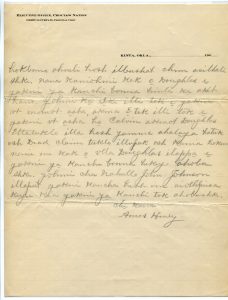I have always loved learning languages. My mother was a high school Spanish teacher, so Spanish was my first (and best) foreign language, even though I have never achieved true fluency (the value of studying abroad cannot be overestimated at all!). I also took six years of French in high school and college as well as a challenging semester of German. I use the Duolingo app every chance I can to explore Irish, Hawaiian, Italian, Czech, Japanese, and Turkish, and eventually I plan to add Vietnamese and Latin. The only Native American language Duolingo has is Navajo, which is currently in Beta testing, but it would be a dream to see even more idigenous languages!
Looking through our collections, I’ve run across materials in the Cherokee, Choctaw, and Muscogee Creek languages which I find fascinating and beautiful. So, today I will share some pictures of handwritten letters as well as links to each Nation’s language website. To my knowledge, there are no translations for the letters I found, so I have no earthly idea what they say; these could be casual letters between friends or official matters of business or law for all I know. Some people may feel frustrated or intimidated looking at materials in other languages, but I love looking at things like this from different perspectives! I even looked up the official definition of language; the first four definitions are what I had in mind when thinking about this post. These linguistic symbols allow for communication among a set of people who, in this case, happen to share the same (or similar) geographic and cultural communities.
Cherokee syllabary has existed for nearly two full centuries!! The history behind it is well worth looking up and learning about!
I recognized Green McCurtain’s name—he was a chief of the Choctaw Nation. I wonder how well Amos Henry knew him and why he was writing. This particular letter caught my attention because it was written on my birthday, seventy-eight years before I was born!
This two page announcement was signed by Gabe E. Parker, whose name I also recognized from my time here in Special Collections! I image there was important information in this announcement and I’m so curious to know what it is. As a Henry Kendall College alum, he was instrumental in Indian Territory and Oklahoma history and also well worth learning about.
Language loss is a disturbingly real problem facing idigenous peoples across the world, which I would give anything to reverse if I could. Language isn’t just for communicating with other humans—it encodes truly unique nuggets of the human experience, and wisdom that, once lost, are irreplaceable because they are found literally nowhere else on Earth. Simply trying to record as much as possible before it’s lost was the presumption of the past and we can do better than that going forward. Programs like these to revitalize daily use both record the language and ensure its continued survival. If you have time, check out these links and learn what you can about these vital language programs!
Muscogee (Creek) Nation Language
We have materials relating to a wide variety of Native American tribes, so if you’d like to see them or the many other collections we hold, please contact us at speccoll@utulsa.edu for arrangements. We are currently open only to TU students, faculty, and staff by appointments made at least 24 hours in advance. You are also welcome to browse our Catalog and Digital Collections and request photocopies or digital scans of materials through the same email. Kelsey and I fulfill requests as quickly as possible, but especially large requests or a high volume of requests may take us up to 4-6 weeks. We are happy to help you as best we can and we hope that you stay safe and healthy!






